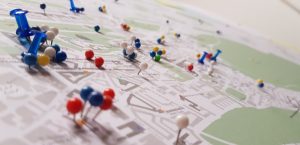
What do citizens value about the City of Edinburgh?
What if we look beyond Old Town’s cobblestone streets and the cliffs of castle rock, and focus instead on different local communities who live in the city, many far outside the centre? What do these contexts tell us about the different ways communities’ access (or have difficulties accessing) cultural events and cultural spaces?
The Culture & Communities Mapping Project led by Morgan Currie, investigated questions such as these. Cultural mapping is a method for citizens to create collective knowledge about place or to shape its cultural policy, by using maps to ask people for their thoughts and feelings about space and place.

The project has so far comprised two rounds of cultural mapping workshops, both with large printed maps that participants mark with stickers and annotated with pencils and pens. The results have taken the form of print maps, online web maps, articles, reports and datasets. The first round of workshops produced an online, interactive cultural map of the city, featuring several unique datasets on cultural spaces that the public can download and use. The Council funded the online map and supplied it with additional public datasets, as they were interested to see the spread of cultural resources across the city.
The second round of workshops
ran in partnership with six community centres (North Edinburgh Arts,
WHALE Arts, granton:hub, Goodtrees Community Centre, Oxgangs
Neighbourhood Centre, and The Ripple Project). These workshops collected
rich stories about the places residents most value in their area and
have shown the incredibly high-value people put on open green spaces in
Edinburgh (likely owing in part to the pandemic). The project resulted
in six intricate print maps, which are being framed and given to each
partner, and is also producing reports to be presented to the community
partners and to local stakeholders, such as Festivals and the Council.
The aim is to help shape cultural activities and approaches to cultural
funding that support areas outside the city centre, especially those in
places of high deprivation.

The research group has also partnered with the grassroots arts organisation LeithLate, resulting in the LeithLate Virtual Tours Map. LeithLate’s popular mural walking tours had been cancelled due to the pandemic, so Morgan’s team helped them design a map-based virtual tour of the Leith area murals, complete with audio recordings of their tour guide’s colourful descriptions of the artworks. The map also includes studio tours by some local artists, commissioned for the map.
Morgan’s group has just produced a very different sort of map, the Festivals & Communities Map,
designed in collaboration with Festivals Edinburgh and the Fringe
Festival, with the help of the Edinburgh Futures Institute. This map
lets people click to see which neighbourhoods in Edinburgh buy tickets
to various festivals, Festivals’ community outreach, and Fringe venues,
in relation to other factors, like the Scottish Index of Multiple
Deprivations and year-round event listings from The List. Festivals
Edinburgh is hoping to use this map to think about its community
outreach strategies and venue locations in the coming years.
Finally, the group is working on a resource called Edinburgh Flaneur, a website that allows people to create customised bike routes across Edinburgh then see what cultural spaces or landmarks are in proximity to the route. This draws on some of the datasets used in the Edinburgh Cultural Map outlined above.
The impact of all this work has taken a few different forms. For one, the projects create new public resources (print maps, web maps, datasets and reports) that other scholars, organisations or the general public interested in the cultural sector in Edinburgh, can use to their own purposes. The projects also have a positive impact on local stakeholders and communities. The LeithLate Virtual Tours can now bring LeithLate’s tours to audience outside of Edinburgh, and they act as an audiovisual archive of Leith’s murals, past and present. The new Festivals & Communities Map supports Festivals Edinburgh’s policies towards local communities. And the latest round of cultural mapping workshops produced asset maps that partner cultural centres can use to envision future placemaking.
Another impact is using maps as a means of knowledge production. The group have publications out or forthcoming, including a book about their various methodologies, their limitations, and how they might be useful for other researchers interested in conducting research on place and culture, using paper and web maps.
Through all of these projects we experiment with map forms and mapping processes, trying out different ways of hearing from residents and stakeholders through maps, and, as a consequence, presenting Edinburgh through the voices of its inhabitants and their distinctive stories about the city.”
Morgan Currie, Lecturer in Data & Society Science, Technology & Innovation Studies, University of Edinburgh.